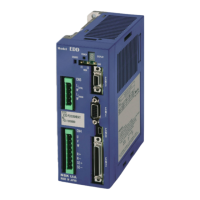— ii —
4.1.4. Monitoring the Current Status ------------------ 4-6
4.1.4.1. Inputting a Command while
Monitoring Multiple Conditions ---------- 4-6
4.2. USB Communication (EDD MEGATERM) ---------- 4-7
4.2.1. Setting Application Software -------------------- 4-9
4.2.2. Establishing Communication------------------ 4-10
4.2.3. Setting Parameters ------------------------------ 4-10
4.2.3.1. Input of the Password ------------------- 4-11
4.2.3.2. Reset to Shipping Set ------------------- 4-12
4.2.4. Readout of Parameter -------------------------- 4-12
4.2.4.1. Monitoring Parameters by a Group -- 4-13
4.2.4.2. Monitoring Parameters Altered from
Shipping Set ------------------------------- 4-14
4.2.5. Monitoring the Current Status ---------------- 4-14
4.2.5.1. Inputting a Command while
Monitoring Multiple Conditions -------- 4-15
5. Tuning ------------------------------------------- 5-1
5.1. Tuning Flowchart ------------------------------------------ 5-1
5.2. Tuning Level 1: Automatic Tuning -------------------- 5-2
5.2.1. Precautions for Automatic Tuning ------------- 5-3
5.2.2. Initialization of Servo Parameters ------------- 5-4
5.2.3. Automatic Tuning ---------------------------------- 5-5
5.2.4. Trial Running ---------------------------------------- 5-7
5.3. Tuning Level 2: Servo Gain Tuning ------------------- 5-9
5.3.1. Input of Load moment of Inertia ---------------- 5-9
5.3.1.1. When the Load moment of inertia is
Unknown ------------------------------------- 5-9
5.3.2. Minor Tuning of Servo Gains ----------------- 5-10
5.4. Tuning Level 3: Manual Tuning ---------------------- 5-13
5.4.1. Precautions for Manual Tuning --------------- 5-13
5.4.2. Setting Velocity Loop Proportional Gain (VG) 5-13
5.5. Setting Filters (Tuning Level 2) ---------------------- 5-15
5.5.1. Setting Low-pass Filter ------------------------- 5-15
5.5.2. Setting Notch Filter ------------------------------ 5-16
6. Operation --------------------------------------- 6-1
6.1. Preparation ------------------------------------------------- 6-1
6.1.1. Wiring Check ---------------------------------------- 6-1
6.1.2. Operation Procedure ------------------------------ 6-1
6.2. Position Scale ---------------------------------------------- 6-2
6.2.1. Resolution of position Scale -------------------- 6-2
6.2.2. Direction of Position Scale ---------------------- 6-3
6.2.3. Setting Home Position ---------------------------- 6-4
6.2.4. Software Over Travel Limit ---------------------- 6-6
6.2.4.1. Setting the Limits by Teaching ---------- 6-7
6.2.4.2. Setting the Limits by Direct Input ------- 6-8
6.3. Positioning Operation ------------------------------------ 6-9
6.3.1. Positioning Command ---------------------------- 6-9
6.3.2. Program Positioning Operation -------------- 6-10
6.3.2.1. Program Operation via Control
Inputs and Outputs----------------------- 6-11
6.3.2.2. Program Positioning Operation via
RS-232C Communication -------------- 6-13
6.3.2.3. Programming ------------------------------ 6-14
6.3.2.4. Program Sequence ---------------------- 6-20
6.3.3. Pulse Train Command Positioning Operation 6-23
6.3.3.1. Format of Pulse Train Input ----------- 6-25
6.3.3.2. Resolution of Pulse Train -------------- 6-26
6.3.3.3. Input Timing ------------------------------- 6-27
6.3.4. Jogging --------------------------------------------- 6-28
6.3.4.1. Jogging with Control Input and Output 6-29
6.3.4.2. Jogging via RS-232C Communication 6-30
6.3.5. RS-232C Communication Positioning
Operation ----------------------------------------- 6-31
6.3.6. Velocity and Torque Control by Analog Input 6-33
6.3.6.1. Selection of Control Mode ------------- 6-33
6.3.6.2. RS-232C Communication Operation 6-34
6.3.6.3. Analog Input Operation ----------------- 6-35
6.3.6.4. Analog Command Input Offset ------- 6-36
7. Operational Function ------------------------ 7-1
7.1. Control Input ----------------------------------------------- 7-1
7.1.1. Emergency Stop: EMST ------------------------- 7-1
7.1.2. Alarm Clear: ACLR ------------------------------- 7-2
7.1.3. Hardware Over Travel Limit: OTP and OTM 7-3
7.1.4. Servo on: SVON ----------------------------------- 7-4
7.1.5. Program Start: RUN Internal Program
Channel Selection: Input PRG0 to PRG7 --- 7-6
7.1.6. Stop: STP ------------------------------------------- 7-7
7.1.7. Jogging: JOG Jogging Direction: DIR -------- 7-9
7.2. Control Output ------------------------------------------- 7-10
7.2.1. Driver Unit Ready: DRDY --------------------- 7-10
7.2.2. Warning: WRN ----------------------------------- 7-10
7.2.3. Over Travel Limit Direction:
OTPA and OTMA --------------------------------- 7-11
7.2.4. Servo State: SVST ------------------------------ 7-13
7.2.5. In-operation: BUSY ----------------------------- 7-14
7.2.6. In-position: IPOS -------------------------------- 7-15
7.2.6.1. CFIN Mode: Parameter FW < 0 ------ 7-16
7.2.6.2. IPOS Mode (Parameter FW = 0) ---- 7-17
7.2.6.3. FIN Mode (Parameter FW > 0) ------- 7-18
7.2.6.4. In-position Limit: Parameter IN ------- 7-19
7.2.6.5. Parameter IS:
In-position Stability Timer ----------------- 7-19
7.2.7. Target Proximity: NEARA and NEARB ---- 7-20
7.2.8. Position Feedback Signal --------------------- 7-21
7.2.8.1. Resolution of Position Feedback
Signal --------------------------------------- 7-22
7.2.8.2. Signal Output Timing ------------------- 7-24
7.3. RS-232C/USB Monitor -------------------------------- 7-25
7.3.1. Monitoring Way for Control
Input/Output Signal ------------------------------ 7-26
7.3.1.1. Electrical Condition Monitor:
Monitor IO0 -------------------------------- 7-27
7.3.1.2. Monitor for Internal Recognition of Input
and Output State: Monitor IO1 ------- 7-28
7.3.1.3. Monitor for State of Input Functions:
Monitor IO2 -------------------------------- 7-28
7.3.1.4. Monitor for State of Output Functions:
Monitor IO3 -------------------------------- 7-29
7.3.1.5. Monitor for Individual Function ------- 7-29
7.3.2. Alarm Monitor ----------------------------------- 7-30
7.3.2.1. Monitor All Occurring Alarms at
One Time ---------------------------------- 7-30
7.3.2.2. Monitor for Alarm History and Event:
Monitor TA/HI ----------------------------- 7-31
7.3.3. Pulse Train Counter: Monitor RP ----------- 7-32
7.3.4. Position Feedback Signal Counter:
Monitor FK --------------------------------------- 7-32
7.3.5. Current Position Monitor: Monitor TP ----- 7-32
7.3.6. Monitor for Software Thermal Loading:
Monitor TJ ---------------------------------------- 7-33
7.4. Analog Monitors ----------------------------------------- 7-34
7.4.1. Use of Preset Monitors ------------------------ 7-35

